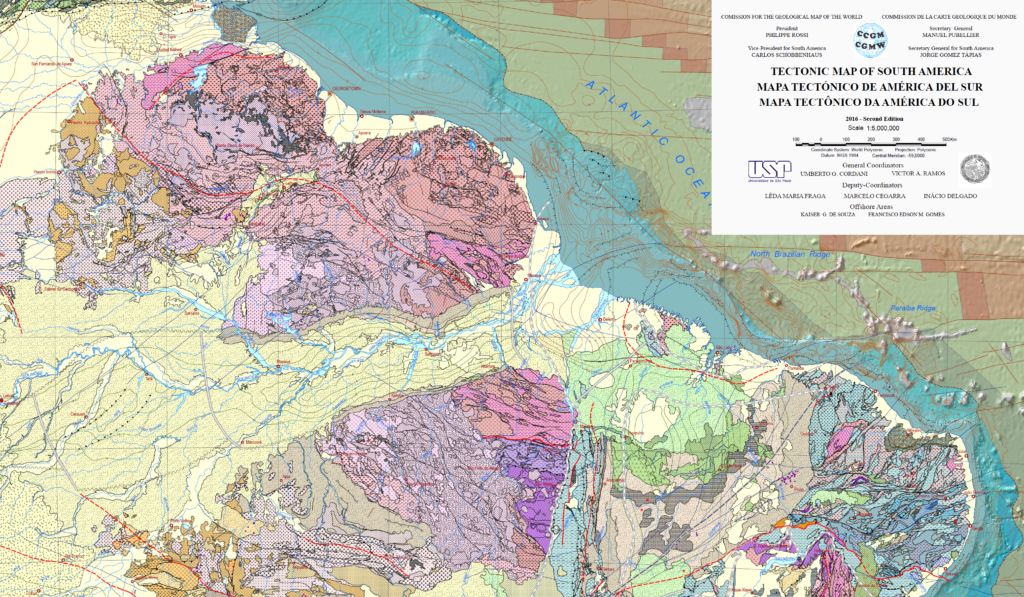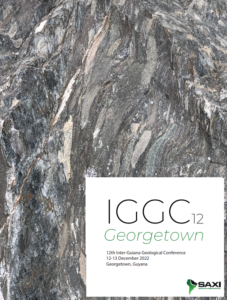Thanks to all presenters and participants for making the IGGC12 a success.
The conference had a great program of speakers, a large number of posters on display and plenty of opportunities to network.
The IGGC12 abstract volume is available for you to download!
A compilation of the oral and poster abstracts chosen for this year’s conference.
Visit the 12th Inter Guiana Geological Conference home page …
The AMIRA SAXI 2 Project is already well underway. For more information, please contact Silvia Black or Mark Jessell

The second stage of the Amira Global P1061B South American Exploration Initiative started on October 1st 2020 and is an integrated 3-year data gathering program that has been inspired by the highly successful West African Exploration Initiative (WAXI, AMIRA Global project series P934) and borrows some of its aims from other successful exploration programs that have led to new discoveries elsewhere in the world.
The Proterozoic Guiana Shield extends over five countries in north-eastern South America (Venezuela, Guyana, Suriname, La Guyane (France) and Brazil) and represents the geological extension of the West African Craton. Between 2006 and 2010 the AMIRA P934 West African Exploration Initiative (WAXI) built up an extensive exploration database for West Africa that is now out of confidentiality. There is no publicly available equivalent database for the Guiana Shield and neighbouring terranes, and the aim of this project is to build a matching knowledge base that can be combined with the WAXI database to produce a seamless coverage for the two regions.
Research Program
The researchers have compiled data from the literature as well as visiting Universities and Geological Surveys from each of the countries that host the Guiana Shield, as some data will be hard to source externally. The overall aim of the South American Exploration Initiative is to enhance the exploration potential of the region through an integrated program of research and data gathering into its ‘anatomy’. Key motivations for undertaking this initiative are to assist exploration companies in focusing their activities in areas of maximum prospectivity and to help local Geological Surveys and Universities in the region in their role of providing pre-competitive data and information.
Specifically, the research team aim to:
- Assist exploration companies in focusing their activities in areas of maximum prospectivity in both greenfields and brownfields areas, and consequently help them to leave an environmental impact as small as possible
- Assist local governments and Geological Surveys in the region in their role of providing pre-competitive data and information in order to further stimulate inward exploration investment
- Identify data and information gaps, in particular in geophysics, geochemistry and geochronology
- Collate the initiative’s results into a single database open to all sponsors and local researchers.
As the Pilot phase of this project comes to an end, the researchers would seek advice on the development of a full research program drawing upon identified data and knowledge gaps.
Benefits
The principal benefits of sponsoring this initiative will include, but are not limited to:
- Exploration GIS: all publicly available geoscience data at local and regional scales will be compiled into harmonised ArcMap and MapInfo projects.
- Reconstructed Data Products: Key datasets will be reprojected so that direct geospatial analysis of the estimated Proterozoic configuration of the West African Craton and the Guiana Shield can be made.
- Organise and conduct seminars and workshops for potential stakeholders: explain aims and objectives of the pilot study and canvass industry to define current and future needs in terms of basic data sets and research.
- Opportunity to define future research directions in the region.
- Opportunity to develop other similar projects in other parts of the world.
Personnel
Stage 2 of the project will be staffed by personnel from The University of Western Australia; The University of Toulouse, The University of Lorraine, Laurentian University and Anton de Kom University of Suriname.
Partnerships with other groups include:
- Prof Anne-Sylvie Andre-Mayer (Uni Lorraine)
- Lenka Baratoux (IRD, Toulouse)
- Aurelien Eglinger (Uni Lorraine)
- Olivier Vanderhaeghe (University of Toulouse)
- Germán Velasquez (Universidad de Chile)
- Lydia Lobato (Federal University of Minas Gerais at Belo Horizonte).
- Stephane Perrouty (Laurentian University)
- Salomon Kroonenberg (Anton de Kom University of Suriname)
Industry Sponsors
-
Barrick
-
GoldAnglogold Ashanti
-
CENTAMIN
-
Newmont
-
Reunion Gold
Regional Survey Support
- Guyana Geology and Mines Commission (GGMC)
- Geologisch Midjinbouwkundige Dienst (GMD)
- Serviço Geológico do Brasil (CPRM)
Other geological surveys, ministries of mines and universities in the region are invited to discuss with the project team how they can be involved as sponsors-in-kind to help build their knowledge infrastructure.


